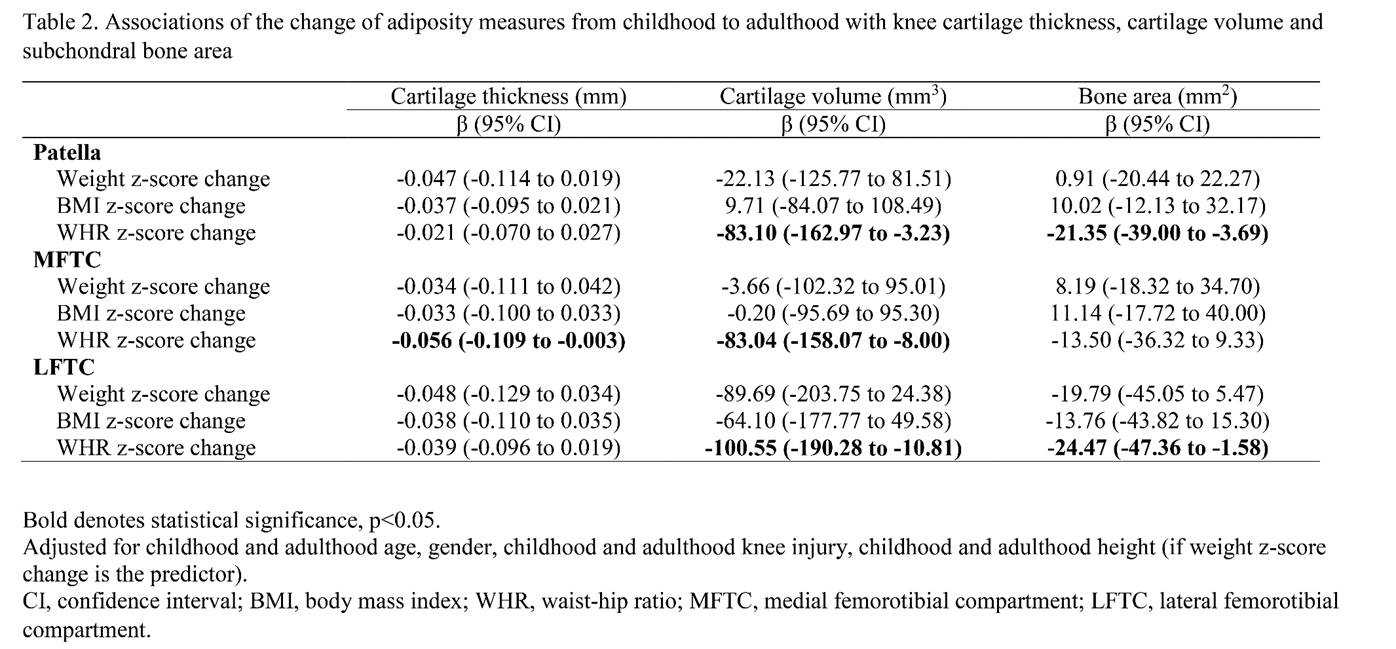Session Information
Session Type: ACR/ARHP Combined Abstract Session
Session Time: 2:30PM-4:00PM
Background/Purpose: Adiposity is associated with increased risk of knee osteoarthritis; cartilage thickness, cartilage volume and subchondral bone area are established biomarkers in knee osteoarthritis. We aimed to describe the longitudinal associations of childhood and adulthood adiposity measures with knee cartilage thickness, volume and bone area in young adults.
Methods: Childhood and adulthood adiposity measures (weight, height, waist circumference and hip circumference) of 186 participants were collected in 1985 (aged 7-15 years) and during 2004-2006 (aged 26-36 years). Knee magnetic resonance imaging was conducted during 2008-2010 (aged 31-41 years), and cartilage thickness, volume and bone area were measured using a quantitative approach (Chondrometrics, Germany). Linear regressions were used to examine the above associations.
Results: The prevalence of overweight was 7.6% in childhood and 42.1% in adulthood. Childhood weight was negatively associated with adult patellar bone area (β=-6.24, 95% confidence interval (CI) -10.25 to -2.22 mm2/kg), while adult weight was positively associated with bone area in medial femorotibial compartment (MFTC) (β=3.09, 1.44 to 4.74 mm2/kg) and lateral femorotibial compartment (LFTC) (β=1.85, 0.19 to 3.51 mm2/kg). Adult waist-hip ratio (WHR) was negatively associated with cartilage thickness (MFTC: β=-0.011, -0.022 to 0.000; LFTC: β=-0.013, -0.025 to -0.002 mm/0.01 unit), volume (Patella: β=-21.85, -37.77 to -5.93; LFTC: β=-23.87, -42.18 to -5.57 mm3/0.01 unit) and bone area (Patella: β=-4.69, -8.26 to -1.12; LFTC: β=-4.76, -9.47 to -0.06 mm2/0.01 unit). The change in WHR z-scores from childhood to adulthood was negatively associated with cartilage thickness (MFTC: β=-0.056, -0.109 to -0.003 mm), volume (patella: -83.10, -162.97 to -3.23; MFTC: -83.04, -158.07 to -8.00; LFTC: -100.55, -190.28 to -10.81 mm3) and bone area (patella: -21.35, -39.00 to -3.69; LFTC: -24.47, -47.36 to -1.58 mm2).
Conclusion: Childhood weight was negatively but adult weight was positively associated with adult bone area. Adult WHR and the change in WHR from childhood to adulthood were negatively associated with cartilage thickness, volume and bone area. These suggest early life adiposity measures may affect knee structures in young adults.
To cite this abstract in AMA style:
Meng T, Venn A, Eckstein F, Wirth W, Cicuttini F, March L, Dwyer T, Cross M, Laslett L, Jones G, Ding C, Eathakkattu Antony BS. Association of Adiposity Measures in Childhood and Adulthood with Knee Cartilage Thickness, Volume and Bone Area in Young Adults [abstract]. Arthritis Rheumatol. 2018; 70 (suppl 9). https://acrabstracts.org/abstract/association-of-adiposity-measures-in-childhood-and-adulthood-with-knee-cartilage-thickness-volume-and-bone-area-in-young-adults/. Accessed .« Back to 2018 ACR/ARHP Annual Meeting
ACR Meeting Abstracts - https://acrabstracts.org/abstract/association-of-adiposity-measures-in-childhood-and-adulthood-with-knee-cartilage-thickness-volume-and-bone-area-in-young-adults/



